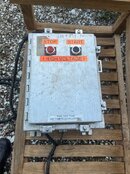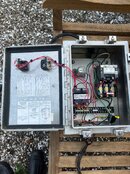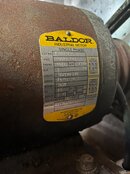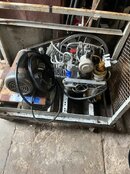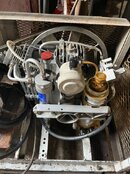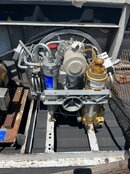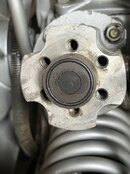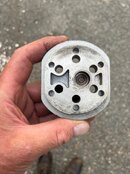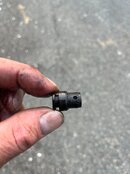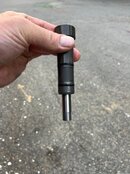Bloody Knuckles
Registered
I recently acquired a 1987 Bauer Capitano off of Craigslist. I believe the unit was originally equipped with a gas engine and converted to electric. The motor currently being utilized is a 3 HP Baldor and it came with a control box (see attached). Subject to the sheave sizes (5" and 18"), I figure it should be operating around 950 RPM (plate on motor says 3450 RPM).
The compressor turns over freely by hand. I drained the oil and inspected for water / contaminates (all good). I replaced the oil to run it for evaluation.
Unit seems to run fine, oil visible in sight glass (no bubbles). It seemed to pump air ok beyond the PMV (no gauge attached yet, so I'm figuring it's pumping around 2,000 PSI if the PMV is working ???).
I ran the unit for about 5 minutes, bleeds worked fine with the typical water / oily mist discharge.
My concerns... The first and second stage warmed up to the touch as expected but the third stage was cool. Is this a possible stuck "floating piston"...I'm really not sure how that system works. Again, it sounded fine...No excessive knocking or rattling. (I'm not sure how it could pump air past the PMV if the piston wasn't working, but why so cool?)
Upon shutdown I could hear air bleeding out the intake. I removed the first stage head, cleaned and inspected the valve components (only minor carbon build up easily removed with a light scrubbing). The cylinder and piston dome looked nice and clean. I re-assembled and ran again...No change.
Before I progress further, I was looking for some thoughts and or direction.
Regarding the PO purification system...Yes, I know it needs to be changed and it will be if I'm not dealing with a hot mess...Baby steps
FWIW, I have little to no experience with the Bauer line. I do own a Coltri MCH-6. (Yes, I know it's a P.O.S. rattle trap, no desire to get into that debate). All's I can say it has treated me well. That being said, the Bauer unit seems to be very rugged and well engineered with any luck I can increase my knowledge base to n=2.
The compressor turns over freely by hand. I drained the oil and inspected for water / contaminates (all good). I replaced the oil to run it for evaluation.
Unit seems to run fine, oil visible in sight glass (no bubbles). It seemed to pump air ok beyond the PMV (no gauge attached yet, so I'm figuring it's pumping around 2,000 PSI if the PMV is working ???).
I ran the unit for about 5 minutes, bleeds worked fine with the typical water / oily mist discharge.
My concerns... The first and second stage warmed up to the touch as expected but the third stage was cool. Is this a possible stuck "floating piston"...I'm really not sure how that system works. Again, it sounded fine...No excessive knocking or rattling. (I'm not sure how it could pump air past the PMV if the piston wasn't working, but why so cool?)
Upon shutdown I could hear air bleeding out the intake. I removed the first stage head, cleaned and inspected the valve components (only minor carbon build up easily removed with a light scrubbing). The cylinder and piston dome looked nice and clean. I re-assembled and ran again...No change.
Before I progress further, I was looking for some thoughts and or direction.
Regarding the PO purification system...Yes, I know it needs to be changed and it will be if I'm not dealing with a hot mess...Baby steps
FWIW, I have little to no experience with the Bauer line. I do own a Coltri MCH-6. (Yes, I know it's a P.O.S. rattle trap, no desire to get into that debate). All's I can say it has treated me well. That being said, the Bauer unit seems to be very rugged and well engineered with any luck I can increase my knowledge base to n=2.



